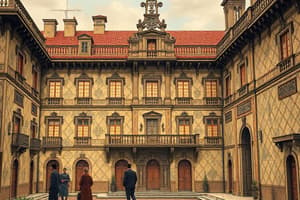Podcast
Questions and Answers
The Bourbon Restoration was only made possible due to foreign intervention.
The Bourbon Restoration was only made possible due to foreign intervention.
False (B)
Cánovas del Castillo advocated for a new constitution with no prior written constitutions as a point of reference.
Cánovas del Castillo advocated for a new constitution with no prior written constitutions as a point of reference.
False (B)
Alfonso XII became king solely through a parliamentary vote.
Alfonso XII became king solely through a parliamentary vote.
False (B)
During the Restoration, only individuals of legal majority could exercise their right to vote.
During the Restoration, only individuals of legal majority could exercise their right to vote.
The Constitution of 1876 established a rigid framework that was very difficult to modify, ensuring long lasting stability.
The Constitution of 1876 established a rigid framework that was very difficult to modify, ensuring long lasting stability.
The political system of the Restoration was based on three central pillars: The Constitution, turnismo and the power of the church.
The political system of the Restoration was based on three central pillars: The Constitution, turnismo and the power of the church.
During the Restoration period, the king solely named individuals from his party to form a new government.
During the Restoration period, the king solely named individuals from his party to form a new government.
The pucherazo consisted of pressuring the electoral college.
The pucherazo consisted of pressuring the electoral college.
The Conservative Party of the Restoration inherited its ideology primarily from radical revolutionary movements.
The Conservative Party of the Restoration inherited its ideology primarily from radical revolutionary movements.
Following Alfonso XII's death, the regency was solely managed by his oldest son, ensuring a smooth transition of power.
Following Alfonso XII's death, the regency was solely managed by his oldest son, ensuring a smooth transition of power.
Flashcards
La Restauración Borbónica
La Restauración Borbónica
Monarchy restored in Spain in 1875 by Alfonso XII.
Antonio Cánovas del Castillo
Antonio Cánovas del Castillo
Political leader of the Conservative Party during the Restoration.
Sandhurst Manifesto
Sandhurst Manifesto
A declaration issued by Cánovas, promising a constitutional government.
Martínez Campos' Pronouncement
Martínez Campos' Pronouncement
Signup and view all the flashcards
María Cristina's Regency
María Cristina's Regency
Signup and view all the flashcards
Constitution of 1876
Constitution of 1876
Signup and view all the flashcards
Turnismo
Turnismo
Signup and view all the flashcards
Pucherazo
Pucherazo
Signup and view all the flashcards
Vote of the 'Lázaros'
Vote of the 'Lázaros'
Signup and view all the flashcards
Vote of the 'cuneros'
Vote of the 'cuneros'
Signup and view all the flashcards
Study Notes
- The Bourbon Restoration in Spain brought back the monarchy in 1875 with Alfonso XII of Bourbon (1875-1885)
Key Aspects of the Restoration
- The restoration was made possible by political actions led by Antonio Cánovas del Castillo.
- Cánovas, the future leader of the Conservative Party secured Isabel II's abdication in favor of her son.
- Cánovas had the backing of the bourgeoisie and the army who desired political stability.
- Cánovas wrote a manifesto, in which the prince pledged a constitutional government, on December 1, 1874.
- The prince signed the manifesto in Sandhurst.
- General Martínez Campos led a military pronouncement on December 29, 1874, in Sagunto, proclaiming Alfonso XII as king.
- Maria Cristina served as regent (1885-1902) upon Alfonso XII's death in 1885, due to Alfonso XIII's minority.
Political System Functionality
- The 1876 Constitution and the rotation of political parties served as the foundation of the Restoration's political system.
The 1876 Constitution
- The constitution was moderate, but flexible enough to permit any party to rule without needing amendments.
- A comprehensive declaration of rights was established, which may be limited based on the party in power.
- Sovereignty was to be shared by the king and the Cortes.
- The governing party was responsible for determining suffrage, which could be limited or universal.
Political Party Rotation
- The peaceful transfer of power between the Conservative Party and the Liberal Party was known as "turnismo."
- Cánovas del Castillo led the Conservative Party, which was supported by the upper classes and was the successor to the moderates.
- Práxedes Mateo Sagasta led the Liberal Party, which was backed by the bourgeoisie and the urban middle classes, and it was the heir of the progressives.
- The king would appoint the leader of the opposition to form a new administration when the government became unstable.
- Elections would be rigged and manipulated in order to secure victory.
- "Pucherazo" refers to electoral fraud and vote manipulation.
- Methods included keeping ballots in a "puchero" to be added to or removed from the ballot box in order to produce the desired outcome.
- The "vote of the dead" ("lázaros" or "fallecidos"), in which deceased individuals were registered to vote.
- The "vote of the 'cuneros'" refers to voters who registered unlawfully in a territorial constituency to which they did not belong.
- Pressure was applied to voters by "caciques" (local bosses) or people with significant economic and social authority at the local or regional level.
Studying That Suits You
Use AI to generate personalized quizzes and flashcards to suit your learning preferences.




